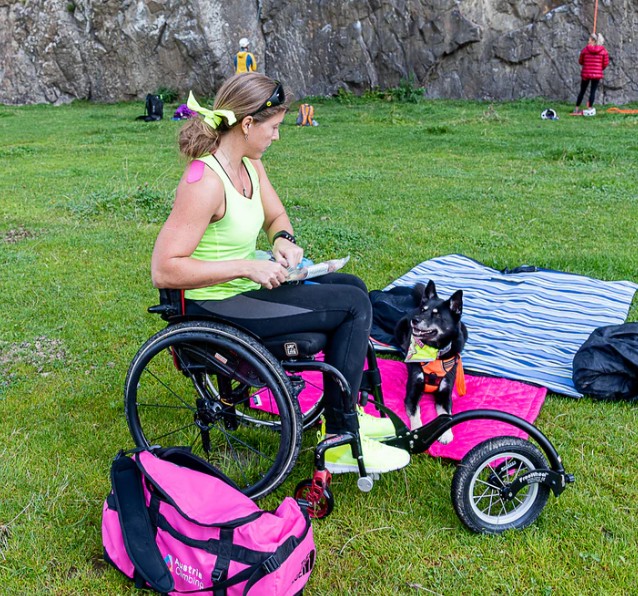How to Roll Your Wheelchair in Grass Without Struggling
Posted by Living Spinal on Aug 12th 2025
How to Roll Your Wheelchair in Grass Without Struggling
Grass might look soft and inviting, but for wheelchair users, it can be one of the toughest surfaces to navigate. The resistance from thick blades, uneven patches, and soft soil can turn a short trip across the lawn into an exhausting workout. From a wedding on a grassy field to an outdoor concert or a relaxing day in the park, knowing how to handle grass in a wheelchair can make all the difference.
Why Wheelchair Rolling in Grass Is Such a Challenge
Grassy terrain presents multiple physical obstacles for wheelchair users:
- Small caster wheels sink or twist – Most everyday wheelchairs have small front casters designed for indoor or smooth-surface use. In grass, these can dig in, creating drag.
- Hidden dips, bumps, and roots – Even a short stretch of lawn can hide uneven ground that jolts your chair or slows you down.
- Thick or wet grass increases resistance – Damp soil clings to wheelchair wheels and adds rolling resistance, forcing you to push harder.
- Energy drain – Constantly adjusting your push stroke and balance takes a toll on your shoulders and arms.
To overcome these issues, the goal is to reduce front wheel contact with the grass, increase traction, and maintain forward momentum.
4 Ways to Help Push Your Wheelchair Through Grass
1. The FreeWheel Wheelchair Attachment
If you regularly find yourself navigating grassy terrain, the FreeWheel Wheelchair Attachment is a game-changer. It works by attaching a single large wheel to the front frame of your chair, lifting your small casters off the ground entirely.
FreeWheel Benefits for grass rolling include:
- Glides over uneven terrain without the front casters digging in.
- Improved stability thanks to a wider rolling footprint.
- Reduced arm strain since there’s less drag from the surface.
- Quick attachment and removal perfect for switching between indoor and outdoor use.
2. Wide Front Casters
Swapping your small casters for larger-diameter, wider wheels reduces the chance of sinking into grass. Pneumatic (air-filled) casters also roll more smoothly over uneven terrain. While they don’t eliminate drag entirely, they’re a noticeable improvement for light outdoor use.
3. All-Terrain Rear Wheels
Wider wheelchair tires with aggressive tread patterns can improve grip and reduce slippage, especially in damp conditions like slick grass.
SUMO All-Terrain Wheels are an excellent way to tackle grass and other tricky terrain with confidence.These wheels were built specifically to deliver unmatched traction. Engineered from the ground up, the SUMO Wheels are a universal off-road upgrade designed to fit almost any standard everyday wheelchair. Their enhanced air-filled design not only grips the ground but also cushions your ride, reducing bumps and jolts along the way.
SUMO Wheels also pair perfectly with the FreeWheel. Combining both the traction of off-road tires and the power of the FreeWheel lets wheelchair users roll through grass effortlessly.
4. Power Assist Devices
Push-assist wheelchair motors (like the SmartDrive or e-motion wheels) can give you an extra boost when pushing through heavy resistance. While more expensive, they can be combined with the FreeWheel or wide casters for the ultimate grass setup.
5. Portable Pathway Mats
For home events or frequently visited grassy spots, roll-out plastic or rubber mats create a smooth temporary path. These work well for yard parties, garden weddings, or community events where you know grass will be unavoidable.
Wheelchair Preparation for Grass Before You Start
Before heading onto grassy terrain, a little preparation can save you a lot of effort:
- Check tire pressure – Fully inflated pneumatic tires roll more easily than underinflated ones.
- Scout your route – Walk the path or visually inspect it to avoid steep slopes, soft mud, or hidden holes.
- Wear gloves with good grip – Wheelchair gloves help maintain consistent push strokes without slipping.
- Start with momentum – The hardest part is the initial push; a strong start helps carry you through thicker patches.
- Adjust your posture – Leaning slightly forward helps keep weight over the rear wheels, improving traction.
Wheelchair Pushing Techniques for Grass
No matter your equipment, technique can make or break your grass navigation:
- Lean slightly forward to keep the drive wheels engaged and improve traction.
- Push in long, smooth strokes instead of short bursts, this helps maintain speed and momentum.
- Angle your approach if the grass is thick, creating a zig-zag pattern to reduce direct resistance.
- Use your core for stability, especially over uneven ground, to reduce strain on your arms.
Enjoying Wheelchair Freedom in Grass
Grass doesn’t have to be a barrier to outdoor fun. Investing in a FreeWheel Wheelchair Attachment, swapping to wide casters, adding power assist, or simply practicing better pushing technique can each bring you closer to a smooth, confident ride.
With the right setup and preparation, you can focus on the event, the view, or the people you’re with, rather than the ground beneath you.

